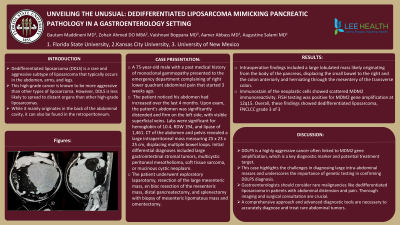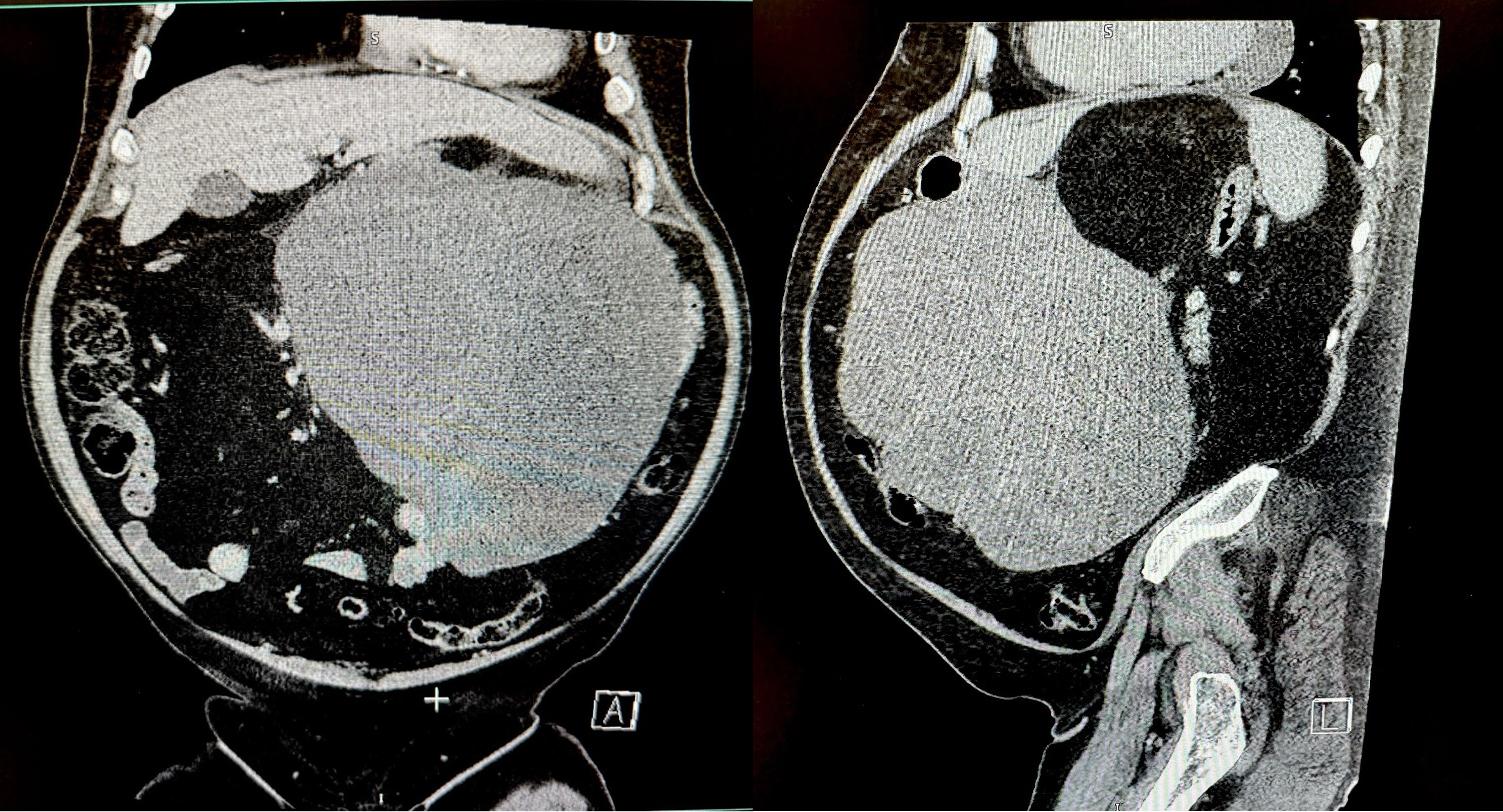Tuesday Poster Session
Category: Biliary/Pancreas
P3504 - Unveiling the Unusual: Dedifferentiated Liposarcoma Mimicking Pancreatic Pathology in a Gastroenterology Setting
Tuesday, October 29, 2024
10:30 AM - 4:00 PM ET
Location: Exhibit Hall E

Has Audio

Gautam Maddineni, MD
Florida State University
Cape Coral, FL
Presenting Author(s)
Gautam Maddineni, MD1, Zohair Ahmed, DO, MBA2, Vaishnavi Boppana, MD3, Aamer Abbass, MD4, Augustine Salami, MD5
1Florida State University, Cape Coral, FL; 2Kansas City University, Cape Coral, FL; 3University of New Mexico, Albuquerque, NM; 4LPG Gastroenterology, Cape Coral, FL; 5LPG Gastroenterology, Fort Myers, FL
Introduction: Dedifferentiated liposarcoma (DDLS) is a rare and aggressive subtype of liposarcoma that typically occurs in the abdomen, arms, and legs. This high-grade cancer is known to be more aggressive than other types of liposarcoma. However, DDLS is less likely to spread to distant organs than other high-grade liposarcomas. While it mainly originates in the back of the abdominal cavity, it can also be found in the retroperitoneum.
Case Description/Methods: A 75-year-old male with a past medical history of monoclonal gammopathy presented to the emergency department complaining of right lower quadrant abdominal pain that started 3 weeks ago. The patient noticed his abdomen had increased over the last 4 months. Upon exam, the patient's abdomen was significantly distended and firm on the left side, with visible superficial veins. Labs were significant for hemoglobin of 10.4, RDW 194, and lipase of 1,461.
CT of the abdomen and pelvis revealed a large intraperitoneal mass measuring 25 x 23 x 25 cm, displacing multiple bowel loops. Initial differential diagnoses included large gastrointestinal stromal tumors, multicystic peritoneal mesothelioma, soft tissue sarcoma, or mucinous cystic neoplasm.
The patient underwent exploratory laparotomy, resection of the large mesenteric mass, en bloc resection of the mesenteric mass, distal pancreatectomy, and splenectomy with biopsy of mesenteric lipomatous mass and omentectomy. Intraoperative findings included a large lobulated mass likely originating from the body of the pancreas, displacing the small bowel to the right and the colon anteriorly and herniating through the mesentery of the transverse colon. Immunostain of the neoplastic cells showed scattered MDM2 immunoreactivity. FISH testing was positive for MDM2 gene amplification at 12q15. Overall, these findings showed dedifferentiated liposarcoma, FNCLCC grade 3 of 3.
Discussion: DDLPS is a highly aggressive cancer often linked to MDM2 gene amplification, which is a key diagnostic marker and potential treatment target. This case highlights the challenges in diagnosing large intra-abdominal masses and underscores the importance of genetic testing in confirming DDLPS diagnosis. Gastroenterologists should consider rare malignancies like dedifferentiated liposarcoma in patients with abdominal distension and pain. Thorough imaging and surgical consultation are crucial. A comprehensive approach and advanced diagnostic tools are necessary to diagnose and treat rare abdominal tumors accurately.

Disclosures:
Gautam Maddineni, MD1, Zohair Ahmed, DO, MBA2, Vaishnavi Boppana, MD3, Aamer Abbass, MD4, Augustine Salami, MD5. P3504 - Unveiling the Unusual: Dedifferentiated Liposarcoma Mimicking Pancreatic Pathology in a Gastroenterology Setting, ACG 2024 Annual Scientific Meeting Abstracts. Philadelphia, PA: American College of Gastroenterology.
1Florida State University, Cape Coral, FL; 2Kansas City University, Cape Coral, FL; 3University of New Mexico, Albuquerque, NM; 4LPG Gastroenterology, Cape Coral, FL; 5LPG Gastroenterology, Fort Myers, FL
Introduction: Dedifferentiated liposarcoma (DDLS) is a rare and aggressive subtype of liposarcoma that typically occurs in the abdomen, arms, and legs. This high-grade cancer is known to be more aggressive than other types of liposarcoma. However, DDLS is less likely to spread to distant organs than other high-grade liposarcomas. While it mainly originates in the back of the abdominal cavity, it can also be found in the retroperitoneum.
Case Description/Methods: A 75-year-old male with a past medical history of monoclonal gammopathy presented to the emergency department complaining of right lower quadrant abdominal pain that started 3 weeks ago. The patient noticed his abdomen had increased over the last 4 months. Upon exam, the patient's abdomen was significantly distended and firm on the left side, with visible superficial veins. Labs were significant for hemoglobin of 10.4, RDW 194, and lipase of 1,461.
CT of the abdomen and pelvis revealed a large intraperitoneal mass measuring 25 x 23 x 25 cm, displacing multiple bowel loops. Initial differential diagnoses included large gastrointestinal stromal tumors, multicystic peritoneal mesothelioma, soft tissue sarcoma, or mucinous cystic neoplasm.
The patient underwent exploratory laparotomy, resection of the large mesenteric mass, en bloc resection of the mesenteric mass, distal pancreatectomy, and splenectomy with biopsy of mesenteric lipomatous mass and omentectomy. Intraoperative findings included a large lobulated mass likely originating from the body of the pancreas, displacing the small bowel to the right and the colon anteriorly and herniating through the mesentery of the transverse colon. Immunostain of the neoplastic cells showed scattered MDM2 immunoreactivity. FISH testing was positive for MDM2 gene amplification at 12q15. Overall, these findings showed dedifferentiated liposarcoma, FNCLCC grade 3 of 3.
Discussion: DDLPS is a highly aggressive cancer often linked to MDM2 gene amplification, which is a key diagnostic marker and potential treatment target. This case highlights the challenges in diagnosing large intra-abdominal masses and underscores the importance of genetic testing in confirming DDLPS diagnosis. Gastroenterologists should consider rare malignancies like dedifferentiated liposarcoma in patients with abdominal distension and pain. Thorough imaging and surgical consultation are crucial. A comprehensive approach and advanced diagnostic tools are necessary to diagnose and treat rare abdominal tumors accurately.

Figure: CT abdomen with contrast showing Abdominal mass originating from pancreas and displacing anatomy of the GI system
Figure1: Coronal View
Figure 2: Sagittal View
Figure1: Coronal View
Figure 2: Sagittal View
Disclosures:
Gautam Maddineni indicated no relevant financial relationships.
Zohair Ahmed indicated no relevant financial relationships.
Vaishnavi Boppana indicated no relevant financial relationships.
Aamer Abbass indicated no relevant financial relationships.
Augustine Salami indicated no relevant financial relationships.
Gautam Maddineni, MD1, Zohair Ahmed, DO, MBA2, Vaishnavi Boppana, MD3, Aamer Abbass, MD4, Augustine Salami, MD5. P3504 - Unveiling the Unusual: Dedifferentiated Liposarcoma Mimicking Pancreatic Pathology in a Gastroenterology Setting, ACG 2024 Annual Scientific Meeting Abstracts. Philadelphia, PA: American College of Gastroenterology.
